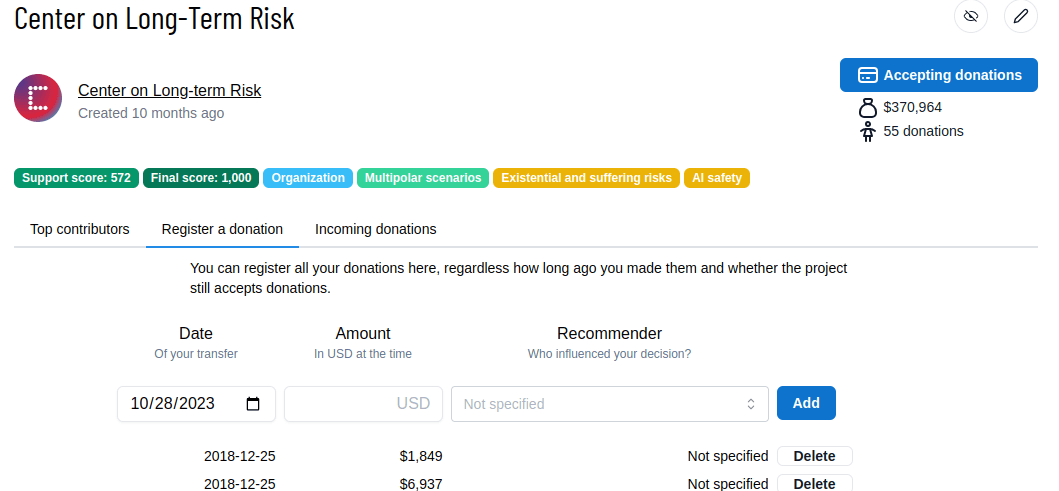The AI Safety GiveWiki aggregates donation data from over 200 EA donors and combines them with retroactive evaluations to generate a list of the top AI safety projects to support. Some 50 donors with a total donation budget of $614,401 want to use it to inform their giving. Please register your donations to improve the platform’s top recommendations, and you may just move some fraction (probably < 10%) of these $614k to a more effective project. |
Introduction
A lot has happened since our last milestone announcement. We more than doubled the amount of funding that you, as regrantor/scout, can move; we renamed to AI Safety GiveWiki, which is more descriptive than AI Safety Impact Markets; and we released the above explainer video. (Though not in that order, so please excuse the use of the old name in the video.)
As for the new name, it succinctly conveys what the platform is about:
- A crowdsourced recommendation engine for giving.
- A place where you can (soon) give away Wiki Credits.
- A place to give quickly (wikiwiki ≈ quick) – counter the Donor’s Dilemma.
How to Regrant
There’s no one on GiveWiki who can flick a switch and make you a regrantor. It’s an organic process where you enter your donations to Project X, and if our evaluators are happy with how Project X turned out, then your reputation on the platform will benefit. With greater reputation (donor score) comes a greater weight in our recommendations.
Right now we only have 14 users who have the ambition to inform our recommendations, so it’s still very easy to get started as a regrantor – or “project scout” as we call them.
Concretely, say, you’ve donated to the Center on Long-Term Risk
Find the project page and select the “Register a donation” tab.
Enter the date of your donation, the amount in USD at the time, and optionally the “recommender” – our recommendations, a particular (other) project scout, or your own research?
Click Add. Congrats! You've registered a donation. The charity will be notified of it and will veto it if it's incorrect.
Repeat it a few more times until you've entered all your donations, and you may become a new top donor!

Tips
- You have a lot of donations to enter? We can help! Just send us a spreadsheet with the project, date, amount, currency, and recommender to hi@givewiki.org.
- A charity you donated to is not yet registered on the platform? Email them and ask them to sign up. It only costs them a few minutes. (But if they’re not in AI safety, the platform might not be the right fit for them at this time.) Failing that, I can create a hidden project for you and register your donations there.
- Look for projects with a high “final score.” The higher the final score, the better your donor score. But our evaluators are working on an update to the final scores right now. There will be plenty of changes and plenty of projects that receive nonzero scores for the first time. (Is it weird to call that score “final” if it changes? How about “evaluation score”?)
- Like a project a lot? Register your donations to it regardless of its current final score. If your donor score is sizable, you’ll buoy it up in our top ranking!
- How much time should you invest? We’re guessing that probably (sadly) only some 10% of our preregistered donors will actually follow through and change their donations based on the GiveWiki recommendations – be it a top project or a project further down that catches their eye. So maybe act like you’re on a committee that allocates $60k. Registering a few years’ worth of donations shouldn’t take more than 30 minutes, so we hope most of you will consider this a good deal.
- Regret a donation? Don’t register it. We’ll eventually build out a few features to encourage completeness and allow donors to disavow registered donations. But until then it would be counterproductive to encourage you to enter such donations.
How to Donate
Are you looking for giving recommendations in AI safety? Check out our current top recommendations and:
Please register your interest here!
It’s a super short form that should take you < 1 minute to fill in. Just your name, email, and approximate annual donation budget. Thank you kindly!
Our evaluators will have fresh scores for our projects in time for the giving season, so stay tuned and check back in December to see how our recommendations have changed!
You can also create an account with the platform so you’ll be informed when a new project registers – just like a big funder!
(You’ll need it anyway when you register your donation – which we ask you to do to give us data on how much money we, and the individual project scouts, have moved.)
Epilogue
If you’d like to support GiveWiki and our work on our long-term vision, please get in touch. We’re looking for SAFE-based investments in our public benefit corporation GoodX.


